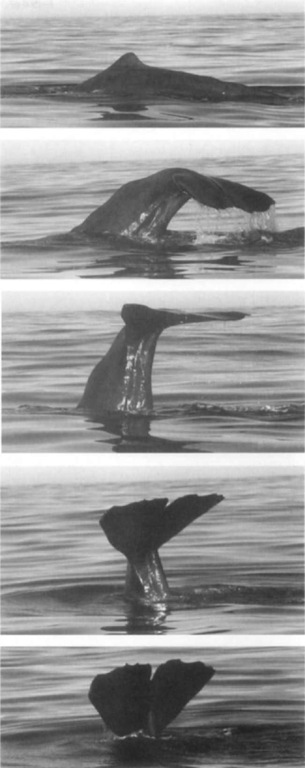Fluking is the act of a whale, dolphin, or porpoise (very rarely, a manatee or dugong) raising its tail, or flukes, above the surface of the water during the beginning of a dive. Usually, whales fluke when diving steeply in water deeper than at least two of their own lengths, although fluking can also occur during shallow submergences. There is great variability in fluking behavior by species: humpback (Megaptera novaeangliae) and sperm whales (Physeter macrocephalus) almost always fluke (Fig. 1) or “fluke out” during the dive; minke whales (Balaenoptera acutorostrata) and fin whales (B. physalus) do so rarely (Leatherwood and Reeves, 1983). Right (Eubalaena spp.), bowhead (Balaena mysticetus), and gray whales (Eschrichtius robustus) are known to vary the amount and type of fluking depending on whether they are feeding near the surface (no fluking), at moderate depth (occasional fluking), or at depths of 60 m or more (“always” fluking). These species also generally fluke on migration, during the final dive after a series of “near-surface” dives between respirations. Even smaller toothed whales, such as bottlenose dolphins (Tursiops truncatus) and pilot whales (Globicephala spp.), at times fluke during deep or at least steeply angled dives (Carwardine et al, 1998).
Large whales fluke as a part of bending their bodies as they angle downward, and the fluke out becomes a natural extension of the animal “rolling” forward and down. In smaller delphinids, however, fluking probably has a distinct advantage during the initiation of the dive: the tail and tailstock (or caudal peduncle) held above the surface provide in-air weight to the body and help propel it downward. The effect of this action is quite similar to human skin divers kicking their feet and legs out of water while bending at the waist as they initiate a dive.
Bowhead whales about to dive steeply often stretch their entire bodies so that head and flukes are at the surface, and the belly or midpart of the body hangs much further below. The spine, in other words, is curved downward. Such a “pre-dive flex” takes about 2 sec and occurs just before the last blow before a dive. The pre-dive flex is almost always predictive of a fluke-out dive, and it and the flukes out indicate steep, generally deep, diving for feeding or migrating (Wiirsig and Clark, 1993).
While fluking is the term properly reserved for the smooth lifting of the flukes above water during the initial stages of a dive, whales and dolphins lift their flukes out of water in other ways as well. A common form is tail slapping (often termed lob-tailing when performed by large whales), consisting of forcefully and often repeatedly slapping the tail onto the surface of the water. This action makes a loud in-air and underwater percussive sound and may well be used to communicate with con-specifics. Tail slapping and breaching often beget more such aerial activities by others, especially when wind and sea states rise; these observations indicate communication and perhaps a social facilitation function of all animals of the area coordinating their states of alertness. Tail slapping may also be used to repel danger as an agonistic display against a conspecific nearby and even to help contain and corral prey near the surface. In humpback whales, tail slapping can be a sign of frustration or anger, as it and breaches are often performed after one male appears to lose during an interactive battle with another one. It is believed that similar evidence of “frustration” has been seen in bowhead, right, and gray whales apparently repulsed by a female. Repeated tail slapping can also be performed “for the fun of it” or as a form of play; in spinner (Stenella longirostris), dusky (Lagenorhynchus obscurus), and probably other dolphins, this appears to be its main function.
Figure 1 A sperm whale (New Zealand) in the act of diving and fluking. Initiation of the dive (top), as the back curves just before lifting the flukes. This fluking sequence shows a particularly high “fluke out” before a fully vertical descent.
A final form of “flukes out” consists of raising the flukes above water and keeping them there for some time. Dolphins wave their flukes about for at times over 1 min, “headstanding” in apparent play; right, bowhead, and gray whales do so for at times over 10 min. It has been suggested diat southern right whales are purposefully sailing by holding their large tails in air during a stiff breeze, but this recreational use of their tails has not been substantiated (Payne, 1995).
Flukes of whales and dolphins have thin trailing edges (similar to the trailing edges of dorsal fins) and are therefore easily tattered or marked by conspecific interactions, getting entangled in lines, or touching other objects. These marks make individual recognition of the flukes possible in those species that habitually fluke out, and fluke-based photographic identification is being practiced for sperm, humpback, and gray whales. In the latter two species, an additional bonus is variable spot or mottling patterns on the flukes (Hammond et al., 1990).

